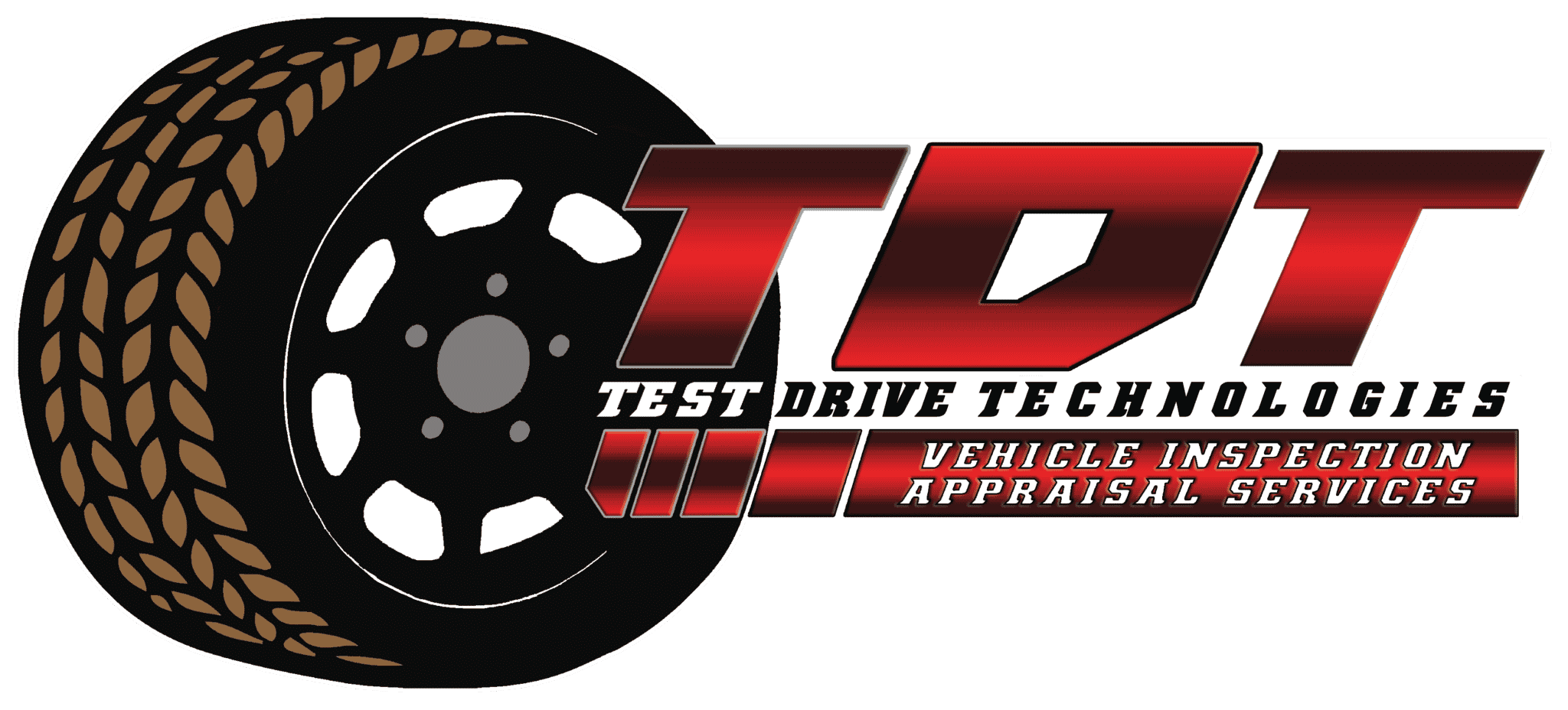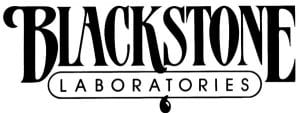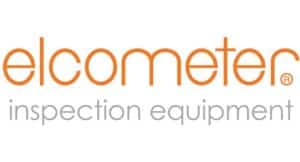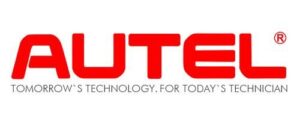This guide is for anyone serious about buying a muscle car — whether it’s your first or your fifth. We cut through the noise to give you a clear, step-by-step breakdown of what to know, what to check, and how to avoid making an expensive mistake. From old-school V8 legends to modern performance machines, this checklist is your no-fluff companion to a smart muscle car purchase.
1. Know Your Why You Are Buying a Muscle Car
Before you shop, answer this: Why are you buying a muscle car? Choose all that apply or rank them as priority.
☐ Show Car
☐ Daily Driver
☐ Weekend Toy
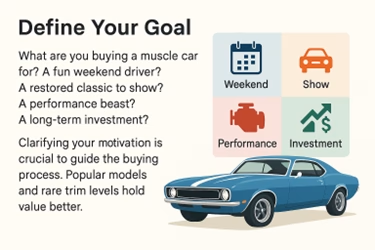
Knowing the goal narrows the options and helps set realistic expectations. A numbers-matching ‘69 Charger isn’t ideal for daily use. A modern Mustang GT might not scratch your vintage itch.
2. Set a Budget — Then Add 20%
Estimate each line item based on your location and the type of car you’re targeting. Use online calculators or quotes where possible. Muscle cars aren’t just about the price tag. Add up the real cost:
☐ $20,000 – $50,000
☐ $50,000 – $80,000
☐ $80,000 – $100,000
☐ $100,000 – $150,000
☐ $150,000 – $200,000
☐ $200,000+
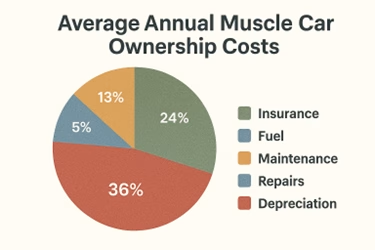
📌 Tip: Always assume an extra 15–20% for unexpected repairs or upgrades.
3. Pick Your Muscle Car Era
Each generation has pros and cons: Classic (1960s–1970s)
- Pros: Raw power, iconic looks, investment potential
- Cons: Poor brakes/safety, expensive parts, rust risk
Retro-Modern (2000s–2010s)
- Pros: More reliable, modern safety, better AC/tech
- Cons: Some models depreciate, hit-or-miss build quality
Modern Muscle (2020s+)
- Cons: Expensive, less DIY-friendly, more electronics
- Pros: Fastest performance, track-ready, warranty options

4. Do the Homework on Muscle Cars
Don’t just browse listings — research:
- Does the Seller Match the Address on Google Maps
- Detailed Description
- Clear Photos from Multiple Angles
- Complete Maintenance / Restoration History
- Seller’s Direct Contact Information
- Look Up Seller on State’s Website
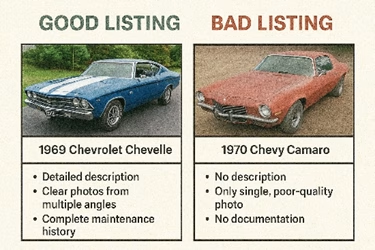
📌 Tip: Just because it has a badge doesn’t mean it’s real. Clones and fakes are common.
5. Inspect and Verify Your Car
You need more than a walkaround. Get hands-on or hire a pro:
- Download Inspection Guides and Checklists
- Is the Pro Independent of the Seller
- Is the Pro Local
- Read the Pro’s Reviews
- Check Yourself
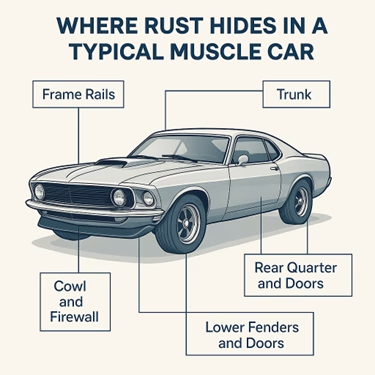
📌 Tip: Use a paint meter and flashlight. Trust, but verify.
6. Purchase Paperwork and Legal Stuff
Clean documentation matters:
- Addresses Verified
- Title
- Bill of Sale
- Restoration Docs
- Receipts
- Maintenance Records
- Repairs
- Dealer License Verified
- Verify Dealer License with State
- Seller Info Verified (Ask for ID)
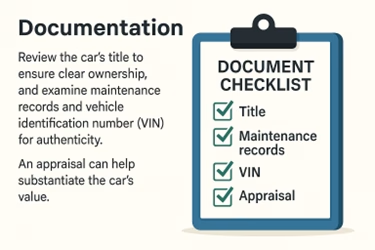
📌 Tip: Buying out of state? Know your DMV process and get a transport permit or temp tag.
7. Close the Deal the Right Way
Protect yourself from fraud
- Use an Escrow Title Service to Facilitate Your Transaction
- Gain the Out of State Title & Verify with the State
- Compare Vehicle Identification Numbers
- Gain Proof of Insurance
- Pay Sales Taxes and Fees
- Transfer Funds and Title Using Escrow
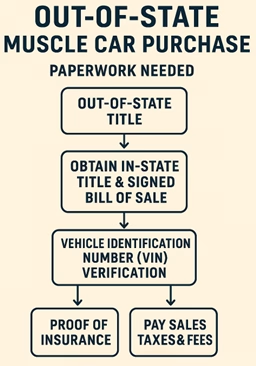
📌 Tip: Walk away from anything that feels shady. There’s always another car.
8. After the Sale
You’re not done once the Muscle Car is in your driveway:
- SOFT Car Covers
- Where and How Will You Store It
- Clean and Sealed Paint (Wax or other Coatings)
- Concrete Floors Need Ventilation
- Use Fans to Avoid Moisture Build Up on Undercarriage
- Put on Stands to Avoid Flat Spotted Tires
- Windows Up
- Rodent Proofing
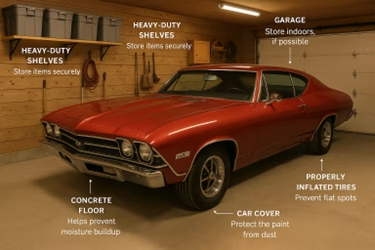
Final Thought
A muscle car should be fun. This checklist is here to keep it that way — no regrets, no surprises, just horsepower and smiles.
CLICK HERE FOR THE PRINT VERSION
This guide has been a courtesy of TDT Vehicle Inspection Appraisal Services free of charge and is not meant to provide any legal or investment advice. Please consult and an attorney or qualified financial advisor before making any investment purchase decisions.
